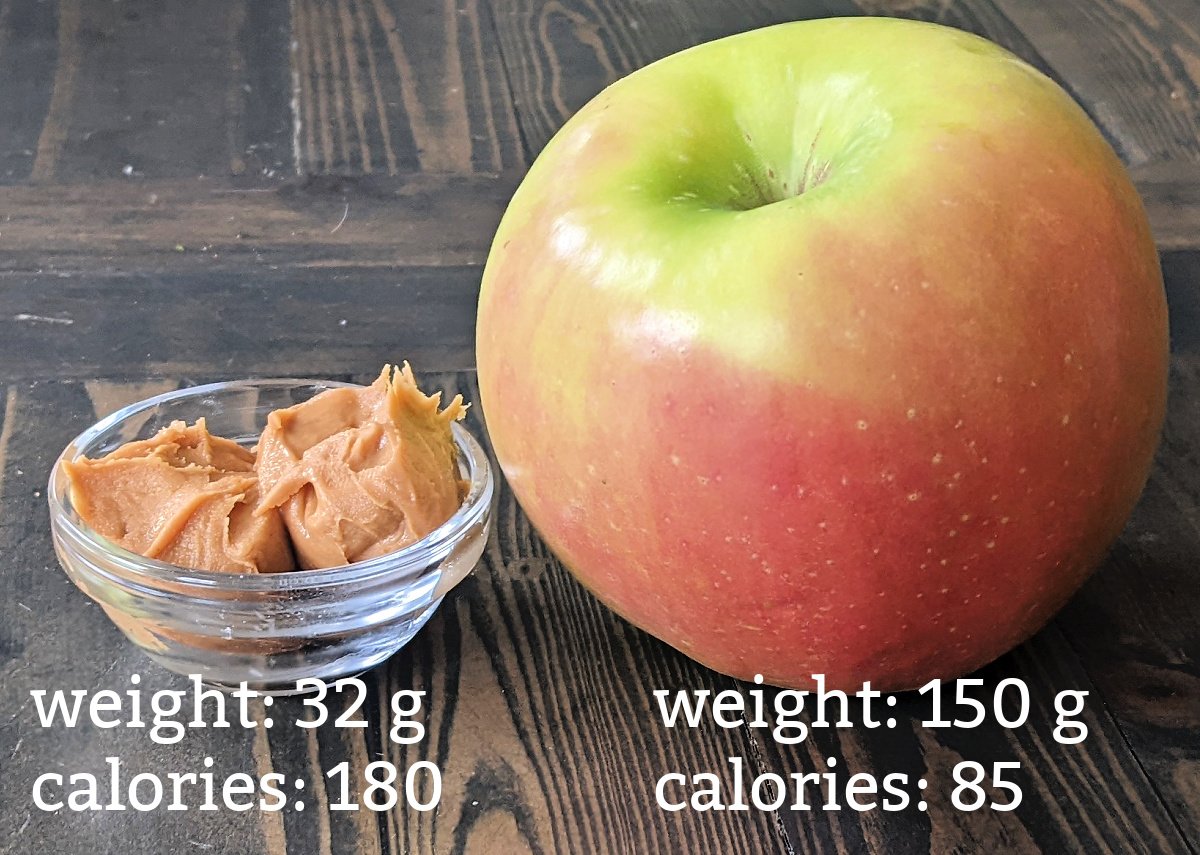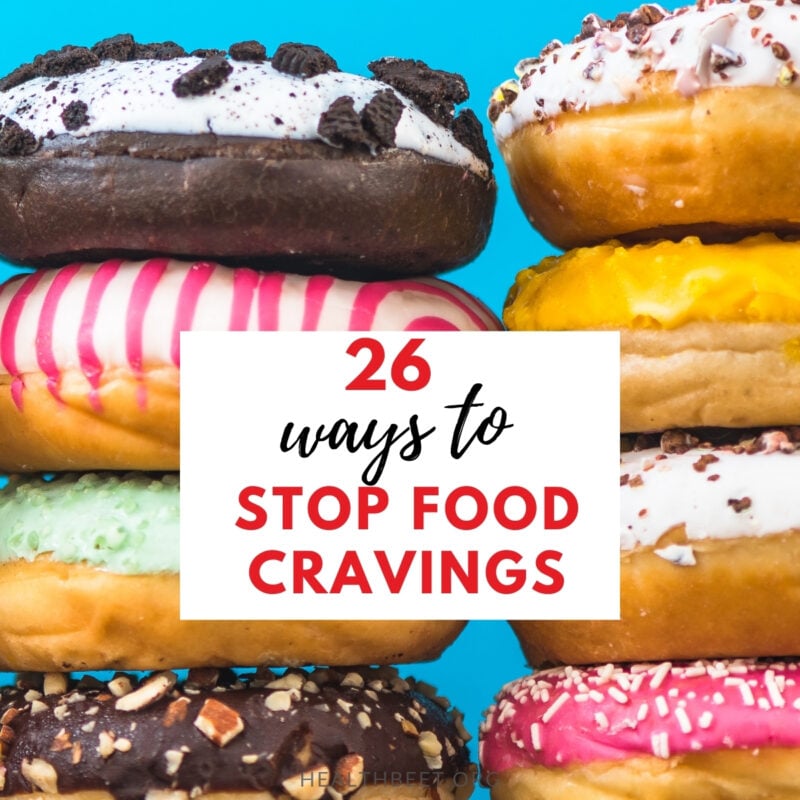How to Use Volume Eating: Eat More Food with Less Calories
Volume eating is food that takes up more space with fewer calories. Think of maximum food with minimum calories! Read on to see examples of food with high volume and low calories.
There are so many different ways to reduce your caloric intake, volume eating might just be my favorite. You can use this method to reduce calories or to eat more fruits and vegetables. Volume eating is simple and easy to sustain. You can adjust as you need to and personalize it to the foods you like.
What is Volume Eating?
Not every food’s calories takes up the same amount of space or volume. Compare an apple to 2 tbsp of peanut butter:
| calories | Fat (g) | Carbohydrates (g) | Protein (g) | Fiber (g) | |
| Apple | 85 | .3 | 22 | .5 | 4.4 |
| Peanut Butter | 180 | 16 | 6 | 8 | 2 |
Want to save this post?
Enter your email below and get it sent straight to your inbox.

The apple is larger in size, and yet has less calories and over all macronutrients than the peanut butter. In most cases fats are more condensed in size for their caloric amount, or calorie dense. Fruits and vegetables have more ‘bulk’ to their volume, mostly made up of water and fiber.
Volume eating is all about eating enough macro and micronutrients while also including foods with more ‘bulk’ or volume.
You’ll eat the same amount of calories but it will be a larger volume, causing you to feel more full.
Macronutrients, like protein and fat are still important when it comes to feeling full. You won’t stay full for too long if you only eat a plate full of broccoli. But adding more bulk like broccoli to your chicken breast and rice will help you avoid overeating during the meal and help you feel satisfied longer after the meal.1 (source)

How does volume eating work?
Volume eating is about adding lower calorie foods, normally fruits, vegetables, grains, beans and lean meats to add volume to a meal. Let’s say for breakfast you want to make eggs.
| Normal Eggs and Toast 2 eggs (156 calories) 2 tsp butter (68 calories) 1 slice toast (75 calories) 1 tbsp strawberry jam (56 calories) Total 355 calories | High Volume Eggs and Toast 2 eggs (156 calories) 1 slice bread (75 calories) 1 cup raw spinach (7 calories) 1 bell pepper (40 calories) 12 strawberries (70) Total 348 |

Both meals are about the same amount of calories and protein. The high volume meal has less fat and added sugar, and instead substitutes those calories to include two servings of vegetables. The high volume meal would take up a whole plate where the normal meal could fit on a slice of toast.
Adding volume can be as simple as adding beans to a soup, more vegetables to a salad, eating whole fruit instead of dried fruit or popcorn instead of crackers.
It isn’t always about swapping foods. Sometimes my high volume meals might be a few more calories than a ‘normal’ meal. It isn’t about comparing meal for meal, it’s about the day as a whole.
The high volume meal will keep me more full for longer. I won’t need to eat a snack as soon after a meal and my total amount for the day will be lower. For example, let’s say I want a turkey sandwich. Instead of eating a turkey sandwich with a piece of cheese, few slices of turkey and two slices of bread, I can add bulk by adding vegetables.
I can add cucumber, carrots, tomato, bell pepper, lettuce, sprouts etc. I didn’t change or remove anything from my sandwich but just about added a full salad to it. Now my meal has more veggies and is more filling.
What Are the Benefits of High Volume Eating?
Including high volume foods can benefit weight loss goals by helping you feel more full with the same amount of calories. You also get additional nutrition benefits. Since most high volume foods are fruits and vegetables you’ll get the vitamins and minerals in them like vitamin C, folate, vitamin K, and potassium.
Most foods high in fiber are also high volume foods. Fiber can help increase satiety by slowing down the digestion process and help you not overeat and stay full longer. 2 The fiber not only helps you feel full, but helps with gut health. Some foods with fiber include oats, whole wheat and fruits.
Because high volume meals contain more food, you’ll eat the same amount of calories in a longer amount of time. When we eat slowly it helps our fullness cues to register before we have overeaten.
Great, Now How Do I Get Started?
I think my favorite thing about volume eating is that you are not limiting what you eat, you can have anything you want. You can personalize it to your goals. If you want to reduce your calorie intake, reduce your portion size and add in more high volume foods. It doesn’t mean you have to restrict what foods you have, it is more focused on the amount. This method helps you not feel the burn out of dieting, you choose your balance of volume eating.
Volume eating can either add something to increase the volume or swap something with less calories. Let’s use the example of having a bowl of ice cream. There are three ways I can apply volume eating method:
- I can add fresh berries to the ice cream
- I can have less ice cream and add berries
- I can swap ice cream for yogurt or a lighter version of ice cream and add berries to that
There is no set way, you get to personalize each meal.
When meal planning I like to start with my base of the meal, this is normally my protein source. Let’s say I am having spaghetti. The main part will be the meat sauce and pasta. So how can I add volume? If I want to make my sauce have more volume I can add lentils, tofu or even diced mushrooms. For the rest of the spaghetti I can add vegetables like mushrooms, zucchini, spinach or maybe I use spaghetti squash instead of all or some of the pasta noodles. The meal now has less pasta per portion and more vegetables.
10 Tips for Volume Eating
- Swap a fatty meat for lean meat, use ground turkey or a leaner ground beef for lasagna
- Prep cooked veggies, cook potatoes, greens like spinach, chard or kale, sauté zucchini and roast brussels sprouts or beets
- Prep fruit, I don’t like having too much prepped, but I’ll slice an apple and maybe eat some for lunch and save some for a snack later
- Canned beans make it easy to add to dishes, like soup or taco salad
- Fruit make a great dessert, I love having berries for a late night treat or this 35 calorie peaches and cream.
- Add egg whites to your eggs for some added protein, I like to still include the egg yolk so I get the nutrients from it
- Use a stronger flavor cheese. I like using parmesan or feta on salads, and other dishes, you don’t need as much as you get lots of flavor.
- Broth based soups are a great way to include protein and veggies with a grain or bean and help you feel full.
- Add veggies to pasta like zucchini, mushrooms, spinach, carrots, eggplant, peas, peppers or broccoli
- Use flavor rich condiments, I like using stronger dressings or sauces, you don’t need as much to get the flavor. And I use them when it counts, I’m not going to add sauce just because it’s there, I use it for the flavor.
Here’s a list of some high volume, low calorie foods to add to your grocery list!
| Pears Apple Orange Banana Berries Carrots Peas Cauliflower Broccoli | Zucchini Potato Green beans Chard Kale Spinach Cucumber Tomato Butternut squash | Eggs Oatmeal Whole wheat Barley Greek yogurt beans/lentil Cottage cheese Quinoa Popcorn Lean meats |






I love this! Simple advice to follow. Thank you for posting “doable” content and ideas.
Thank you Alanna! I’m so glad it resonates with you!